|
|
|
Sort Order |
|
|
|
Items / Page
|
|
|
|
|
|
|
| Srl | Item |
| 1 |
ID:
177991
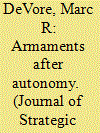

|
|
|
|
|
| Summary/Abstract |
State investments in domestic defence industries are one of the most puzzling trends in international relations. Economists contend that these investments waste resources, while political scientists claim that armaments’ resultant overproduction fuels arms races. Why then do governments cultivate defence industries? I draw on cases from Israel, South Africa and Iraq to argue that the answers to these questions are distinct. Fears about supply security frequently spur states to begin developing arms industries, and elites’ techno-nationalist beliefs often sustain their defence-industrial investments. Defence industries’ primary national security value, however, lies in their hitherto unappreciated contribution to states’ military adaptation capacity.
|
|
|
|
|
|
|
|
|
|
|
|
|
|
|
|
| 2 |
ID:
177948
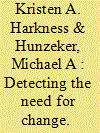

|
|
|
|
|
| Summary/Abstract |
This article addresses a gap in the literature on military adaptation by focusing on the first step in the adaptive process: detecting failure. We argue that institutionalised feedback loops are a critical mechanism for facilitating detection. Feedback loops are most effective when they filter information and distribute lessons learned to senior tactical commanders. In turn, effective filtration depends on incorporating frontline soldiers and specialists into intelligence cells while creating a protected space for dissent. We evaluate our theory against both irregular and conventional wars fought by the British Army: the counterinsurgency campaign in the Southern Cameroons (1960–1) as well as the evolution of British assault tactics on the Western Front of the First World War (1914–18).
|
|
|
|
|
|
|
|
|
|
|
|
|
|
|
|
| 3 |
ID:
153052
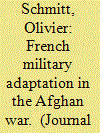

|
|
|
|
|
| Summary/Abstract |
For some, a specific feature of the French armed forces' adaptation process in the adaptation process would be the capacity to look inward instead of outward in order to identify relevant solutions to tactical/doctrinal problems. This article questions such a narrative, and argues that the French armed forces are as quick as any to borrow from other countries’ experiences. In order to do so, this article introduces the concept of ‘selective emulation’, and compares the French and German military adaptation processes in Afghanistan. The article argues that there is indeed something distinctive about French military adaptation, but it is not what the fiercest defenders of the French ‘exceptionalism’ usually account for.
|
|
|
|
|
|
|
|
|
|
|
|
|
|
|
|
| 4 |
ID:
137247


|
|
|
|
|
| Summary/Abstract |
This article analyses the impact of the Korean War on the Chinese People’s Liberation Army (PLA), particularly the period of positional warfare from 1951 to 1953. In the war of movement between October 1950 and June 1951, the PLA relied on its civil war era weapons and experience, including the doctrine of ‘battle of annihilation’. Operations in early 1951 suggested that the civil war legacies of the PLA no longer applied to the realities of combat in Korea. Based on both Soviet aid and domestic mobilisation, the PLA managed to build the material foundation for positional warfare and rapidly improved its logistics. Operationally, on the defensive, the PLA developed combined operations integrating infantry, artillery, and armoured forces. The PLA learned the lessons of the Korean War and strengthened its ties with the Soviet armed forces in order to modernise itself. The Korean War thus transformed the PLA from Civil War victor to Cold War guard.
|
|
|
|
|
|
|
|
|
|
|
|
|
|
|
|
| 5 |
ID:
103299
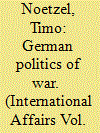

|
|
|
|
|
| Publication |
2011.
|
| Summary/Abstract |
This article analyses the way in which Germany's participation in the international intervention in Afghanistan has shaped and transformed the country's politics of defence and deriving policies. It argues that in the wake of operational challenges posed by the insurgency in northern Afghanistan since 2007, and in particular the increasing rate of German combat fatalities, established post-Cold War dogmas of German politics are becoming subject to erosion. Developments in the Kunduz region of northern Afghanistan, with the tanker bombing of 4 September 2009 as its apex, have had a catalyst function in this process. In particular, strategic, operational and tactical requirements for counterinsurgency operations have had significant politico-strategic repercussions for the country's defence and security policy more generally. As a result, in recent years the Bundeswehr has begun to undergo a far-reaching structural process of military adaptation and innovation. The article explains and analyses this phenomenon of political change and military learning in the context of political paralysis.
|
|
|
|
|
|
|
|
|
|
|
|
|
|
|
|
| 6 |
ID:
108710
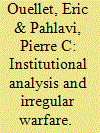

|
|
|
|
|
| Publication |
2011.
|
| Summary/Abstract |
This article proposes a case study to illustrate the usefulness of sociological institutional analysis as a method to uncover 'blue force' challenges to deal with irregular warfare. The French Army's adaptation to revolutionary warfare in Algeria, starting in 1954, is used to illustrate both the application of the methodology and how institutional forces can hinder as well as overwhelm transformation for irregular warfare. The analysis emphasizes three key dimensions of the French Army's institutional adaptation: the regulative, normative and cognitive. These empirical elements are used to show how they interacted and influenced the institutional implementation of the French COIN structures.
|
|
|
|
|
|
|
|
|
|
|
|
|
|
|
|
| 7 |
ID:
164290
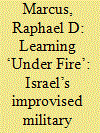

|
|
|
|
|
| Summary/Abstract |
What organisational attributes enhance a military’s ability to effectively adapt on the battlefield? Upon the outbreak of war in July 2014 between Israel and the Palestinian militant group Hamas, the Israel Defense Forces (IDF) encountered an expansive network of tunnels from which Hamas was launching large-scale assaults into Israel. This article illustrates that the IDF’s ability to successfully adapt ‘under fire’ to this battlefield surprise was facilitated by several important attributes related to its organisational learning capacity: a dynamic, action-oriented organisational culture, a flexible leadership and command style, specialised commando units which acted as ‘incubators’ for learning and innovation, and a formal system to institutionalise and disseminate lessons learned.
|
|
|
|
|
|
|
|
|
|
|
|
|
|
|
|
| 8 |
ID:
186094
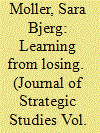

|
|
|
|
|
| Summary/Abstract |
When and why do coalitions adapt in wartime? Drawing on insights from organizational research and bargaining theories of war, this paper develops a model of coalitional military adaptation. I argue that coalition members are slow to adjust their wartime fighting arrangements owing to collective action problems as well as the military and political practicalities inherent in coalition warfare. I illustrate my argument with a case study of the Austro-German coalition in World War I.
|
|
|
|
|
|
|
|
|
|
|
|
|
|
|
|
| 9 |
ID:
149020
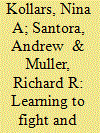

|
|
|
|
|
| Summary/Abstract |
A military cannot hope to improve in wartime if it cannot learn. Ideally, in wartime, formal learning ceases and the application of knowledge begins. But this is optimistic. In 1942, USAAF Eighth Air Force assumed it had the means necessary for victory. In reality, its technique and technology were only potentially – rather than actually – effective. What remained was to create the practice of daylight bombing – to learn. This article (1) recovers a wartime learning process that created new knowledge, (2) tests existing tacit hypotheses in military adaptation research, and (3) offers additional theoretical foundation to explain how knowledge is created in wartime
|
|
|
|
|
|
|
|
|
|
|
|
|
|
|
|
| 10 |
ID:
149018


|
|
|
|
|
| Summary/Abstract |
This article – based on interviews with Norwegian Provincial Reconstruction Team (PRT) commanders and the lessons-learned database of the Norwegian Armed Forces – argues that what appear to be an inability or unwillingness to learn and adapt in war may have other explanations. The ambiguity of experiences makes lessons contested, contradictory, and fluid interpretations of confusing events. Consequently, they do not provide unequivocal guidance for adaptation. Even when lessons learned are fairly clear and agreed upon, adaptation does not automatically follow, as force autonomy may be quite limited, at least for small states in coalition operations conducted in partnership with indigenous forces.
|
|
|
|
|
|
|
|
|
|
|
|
|
|
|
|
| 11 |
ID:
186901


|
|
|
|
|
| Summary/Abstract |
Existing studies focus on explaining how militaries adapt in different ways to the challenges of war. However, organisation theory suggests that competition and normative pressure will lead overtime to convergence within particular business and policy sectors, as optimal ways of organizing and operating are learned and emulated. I examine this dynamic in the context of the conflict between the Afghan Taliban and the British Army. That there should be convergence in modes of operation or organizational form between these two very different opponents seems most improbable. Yet, as this article shows, convergence did occur as the conflict wore on.
|
|
|
|
|
|
|
|
|
|
|
|
|
|
|
|
| 12 |
ID:
138744
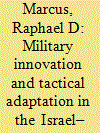

|
|
|
|
|
| Summary/Abstract |
This article highlights a pattern of military adaptation and tactical problem-solving utilized by the Israel Defense Forces (IDF) while engaged in protracted conflict with the Lebanese militant group Hizballah. It discusses the IDF’s recent attempts to institutionalize their historically intuitive process of ad-hoc learning by developing a formal tactical-level mechanism for ‘knowledge management’. The diffusion of this battlefield lesson-learning system that originated at lower-levels of the organization is examined, as well as its implementation and effectiveness during the 2006 Lebanon War. A nuanced analysis of IDF adaptation illustrates the dynamic interplay between both ‘top-down’ and ‘bottom-up’ processes of military innovation.
|
|
|
|
|
|
|
|
|
|
|
|
|
|
|
|
| 13 |
ID:
141150


|
|
|
|
|
| Summary/Abstract |
Tactical learning is critical to battlefield success, especially in a counterinsurgency. This article tests the existing model of military adaption against a ‘most-likely’ case: the British Army’s counterinsurgency in the Southern Cameroons (1960–61). Despite meeting all preconditions thought to enable adaptation – decentralization, leadership turnover, supportive leadership, poor organizational memory, feedback loops, and a clear threat – the British still failed to adapt. Archival evidence suggests politicians subverted bottom-up adaptation, because winning came at too high a price in terms of Britain’s broader strategic imperatives. Our finding identifies an important gap in the extant adaptation literature: it ignores politics.
|
|
|
|
|
|
|
|
|
|
|
|
|
|
|
|
| 14 |
ID:
185342


|
|
|
|
|
| Summary/Abstract |
This article examines the development and performance of formal organisational learning processes in the Ukrainian Armed Forces (UAF) during the Donbas War (2014-present). Through original empirical research conducted with UAF personnel and documentary analysis, the article develops understanding about the detail of UAF lessons-learned processes and their effectiveness in helping to recalibrate UAF activities to operational demands. The article finds that the performance of UAF lessons-learned processes during the Donbas War has, on the whole, been poor. Since the escalation of Russian aggression in 2014, some positive steps which have been taken to implement best-practices in UAF lessons-learned processes. However, the article uncovers a number of organisational activities, structures and processes which could be improved to weaken the negative impact of bureaucratic politics and organisational culture on learning. It concludes with recommendations for the further development of UAF lessons-learned processes. The article highlights the particular importance of improving the capacity of the civilian leadership to exert effective oversight of military learning and of US and NATO support for these efforts.
|
|
|
|
|
|
|
|
|
|
|
|
|
|
|
|
| 15 |
ID:
163579


|
|
|
|
|
| Summary/Abstract |
In wars fought against insurgents, civilian casualties present the challenging dilemma of balancing security and stability while targeting insurgents who operate within the civilian population. In Afghanistan, the International Security Assistance Force (ISAF) has made minimizing civilian casualties a top-tier strategic issue. Yet beyond annual reports, there has been a lack of data-driven analysis into the number of civilians killed by ISAF operations. This research investigates ISAF-caused civilian casualties between 2010 and 2013, incorporating civilian casualty events to investigate changes in ISAF “lethality.” This analysis finds that although ISAF-caused civilian casualties decreased overall, this was mitigated by the tactic employed (airpower vs. on the ground operations). The implications of this analysis for theories of military adaptation, future population-centric operations, and current military operations (e.g., in Iraq and Syria) are discussed.
|
|
|
|
|
|
|
|
|
|
|
|
|
|
|
|
| 16 |
ID:
186086


|
|
|
|
|
| Summary/Abstract |
Following Moltke’s dictum that ‘no battle plan ever survives contact with the enemy’, military learning and adaptation has long been a staple of military studies. Over the past fifteen years, much of the literature has been focused on Western armed forces in Afghanistan and Iraq. Little attention has been paid thus far to adaptation by the Iraqi armed forces in their fight against ISIS. Whereas the Iraqi army was routed by the group in 2014, three years later it managed to take back almost all the territory lost to ISIS. How was that possible? This article discusses military adaptation by the Iraqi armed forces and their role in the military defeat of ISIS in Iraq. Combining an academic theoretical framework on military adaptation with a primary source-based investigation of the Iraqi fight against ISIS, we reconstruct how the Iraqi armed forces learned from their mistakes in 2014 and which role this process played in the military defeat of ISIS in Iraq.
|
|
|
|
|
|
|
|
|
|
|
|
|
|
|
|
| 17 |
ID:
153709
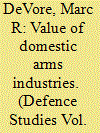

|
|
|
|
|
| Summary/Abstract |
Few issues are more important yet less understood than how the domestic production of armaments impacts military power. Scholars generally explain states’ drive to develop defense industries in terms of a quest for supply security. Technological changes are, however, rendering an “autonomy preference” increasingly unaffordable. This raises the question of whether states can still derive strategic value from their defense industries. This study addresses the issue by examining whether Israel’s and Serbia’s defense industrial bases contributes to either the traditional goal of supply security or the alternative objective of military adaptability. To preview the conclusion, the strategic value that most states can extract from domestic defense firms lies in enhanced military adaptability. This advantage is far from negligible. Since war is unpredictable, it is often the side that adapts most rapidly to unexpected circumstances that prevails. Domestic defense industries contribute significantly to adapt both because of their technical capabilities and their patterns of routinized cooperation with a states’ armed force. Supply security, by way of contrast, is today unattainable for all but the largest states.
|
|
|
|
|
|
|
|
|
|
|
|
|
|
|
|
| 18 |
ID:
138745


|
|
|
|
|
| Summary/Abstract |
Wartime adaptation is a process of adjustment from the war you planned for to the one you have. This process of adjustment is done, in part, by the practitioners of war in the theater of conflict–soldier-led adaptation. Drawing upon two case studies of gun truck development in Iraq and Vietnam I argue that soldiers created networks in order to adapt to battlefield challenges and that the pattern of those networks carries implications for the likelihood of formal adoption by the organization. Simply put, the pattern of the flow of ideas, resources, and skills across the battlefield may affect the likelihood of bottom-up adaptation.
|
|
|
|
|
|
|
|
|
|
|
|
|
|
|
|
| 19 |
ID:
189427


|
|
|
|
|
| Summary/Abstract |
The study of military innovation is one of the most important topics in the strategic studies arena, but when it comes to defining the term ‘military innovation,’ there is a remarkable lack of consensus. Lack of agreement on a definition makes it harder to advance knowledge beyond specific cases and for ongoing research to have policy relevance. Currently, what one might consider an innovation another might call an adaptation of an existing technology or tactic, or neither. To move forward, we survey dozens of existing studies and review articles for proposed definitions and examples of military innovation. We locate common and differentiating themes across a wide range of definitions and (at times) conflicting conceptual terminology. We then propose a new framework for thinking about military innovation that builds on existing research and suggests a path forward for future research. Finally, in an online appendix, we demonstrate the plausibility of the framework applied to prominent cases.
|
|
|
|
|
|
|
|
|
|
|
|
|
|
|
|
|
|
|
|
|